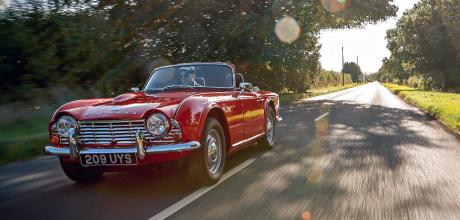1962 Triumph TR4
We have a 1962 Triumph TR4, some of the best roads in the country and 48 hours to kill. Join us on the perfect classic tour to kick off our guide to the top 50 British drives for a lively 2023.
WORDS NIGEL BOOTHMAN
PHOTOS LEWIS HOUGHTON
When did you last have a classic-car holiday? We do just that
Hit The Road! Armed with a Triumph TR4, we go for a classic weekend exploring North Yorkshire.
PLUS — 50 great drives to take in the UK and Ireland in 2023
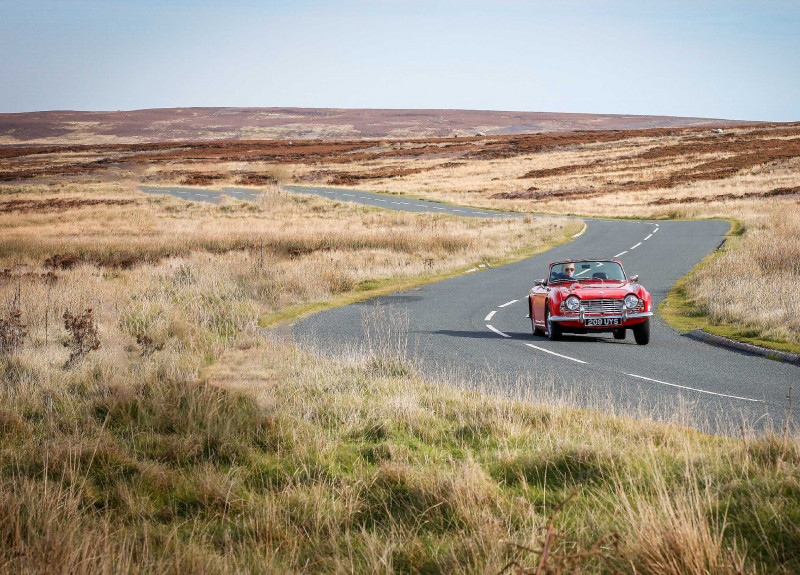
You have to be careful who you tell. My plan for the next two days is sensitive information, not because it’s top secret but because it might provoke bitter jealousy. After all, if you tell people that you’re borrowing a classic softtop Triumph and exploring the best roads of the North York Moors for a couple of days, any friends twiddling their thumbs at home or stuck in the office would find it hard to be polite. The forecast looks good too. Days of rain blow away into blue skies as we pick up the car near the pretty market town of Malton in the North Riding of Yorkshire. I’m about half an hour up the A64 from York, which itself makes an excellent stepping-off point for classic car adventures if you need a mainline railway station. But while the Vale of York has many excellent features, if it’s hilly scenery and thrilling roads you’re after, head north. Malton is on the edge of the Howardian Hills, themselves an extension of the Moors just outside Pickering.
‘Dalby Forest conjures up memories of the RAC Rally in its golden days — time to pretend I’m in a works car’
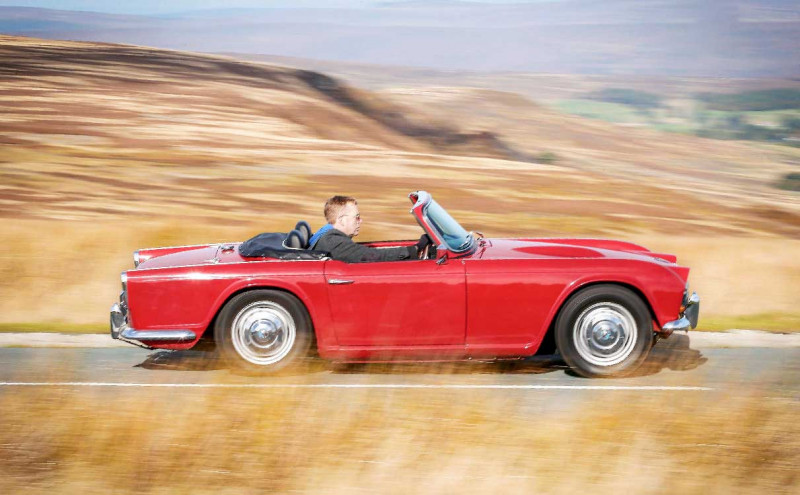
Nosing the TR4 through the lanes towards the edge of the National Park is a good introduction to the car before the faster roads appear. Two things make an instant impression: it’s quicker than expected and it rides surprisingly well. The performance seems to flow from that age-old formula of putting a relatively large, torquey engine into a small, lightweight car.
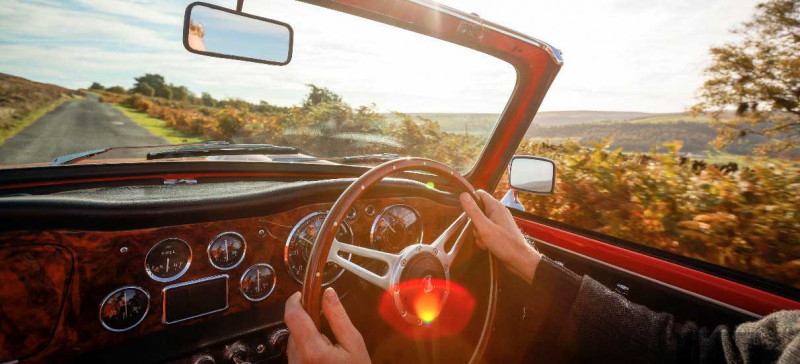
This is no high-revving, overhead-cam screamer, this is the famously robust and versatile Standard-Triumph pushrod four, which served the TR range so well from the first TR2 in 1953 to the last TR4A in 1967. Here, in 2138cc form, it has 15bhp more than the Standard Vanguard saloon’s 1998cc engine, which has to shift an extra 200kg over the TR4’s kerb weight. It offers healthy gob-fulls of go from just off idle, and even accelerating hard you find yourself changing up before 4000rpm on the pretty Smiths tachometer, though it would happily spin faster.
Then there’s the ride. We’ll be encountering all manner of British tarmac on this trip, including some of those all-too familiar surfaces that have more in common with an artillery range than a snooker table. Memories of earlier TRs – and perhaps also of a couple of later and rather worn-out TR6s – cause worries about a spine-jarring lack of suspension travel. But it’s just not the case. When well-restored and set up properly, a TR4 turns out to be a supple and pliant car by the standards of any classic roadster. There’s a bit of body roll, as you’d expect from something of this era that isn’t screwed down tight like a skateboard, but there’s none of the crashing into potholes that makes you tense up when you see a bump ahead.
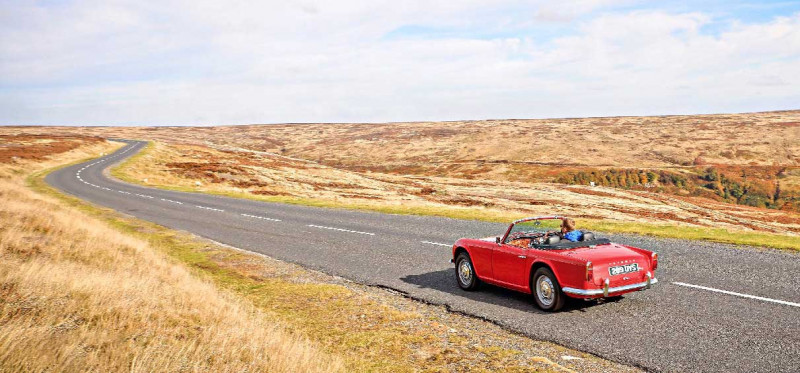
Pickering is busier than Malton, and marks the southern end of the North Yorkshire Moors Railway. This heritage line is one of the longest and best-known of its type, running through Levisham, Newton Dale, Goathland and Grosmont, and all the way to Whitby until summer is deemed to have turned into autumn. Which happens rather late in the optimistic minds of the Railway’s volunteer staff, meaning we should get a chance to see and hear steam-drawn services during our trip.
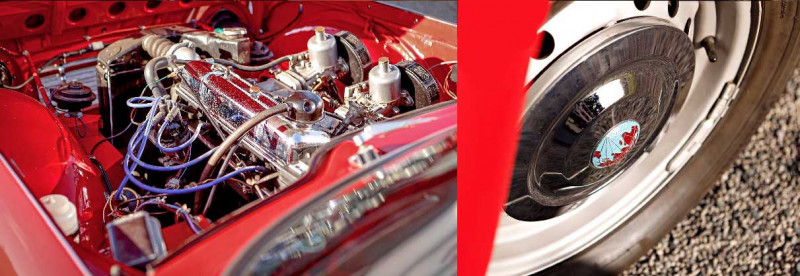
For those fired by petrol rather than coal, the name of Dalby Forest should conjure up memories of the RAC Rally in its golden days. The Trackrod Rally and Dalby Forest Rally continue to make use of some of the same tracks to this day. There is even a forest drive aimed at tourists, but it’s all smooth tarmac and 30mph limits, which won’t give the TR4 a chance to pretend it’s part of Graham Robson’s Triumph works team from 1962. And I’m keen to find out what it’s like on the open road.
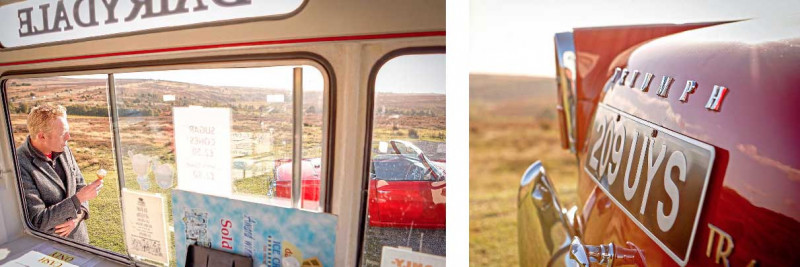
Up the A169, then, and I’m soon climbing into moorland scenery with the typical mix of traffic: dawdling holidaymakers in camper vans, and huge logging lorries trying to break a personal best from one depot to another. Changing down into third – it’s a notchy change but behaves perfectly as long as you’re positive – gives urgency that carries the car past the camper vans and out of the way of the raging HGVs.
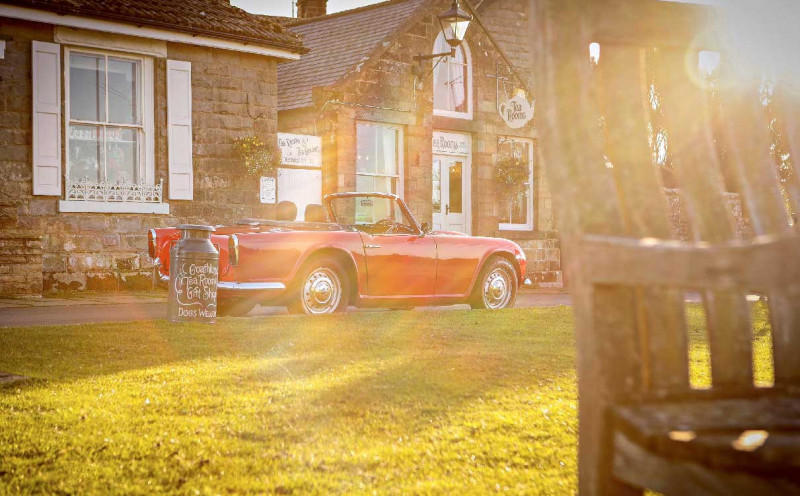
There is RAF Fylingdales, the peculiar and somewhat sinister-looking radar installation over to the east of the main road. Local legend, and indeed eye-witness statements from one chap I chat to, suggests it’s blamed for interfering with modern remote-control car keys… leaving some puzzled motorists stranded in the Goathland Viewpoint Car Park. I allow myself a smug little smile at the thought of the TR4’s total immunity to these first-world problems, and carry on down the side road to Goathland.
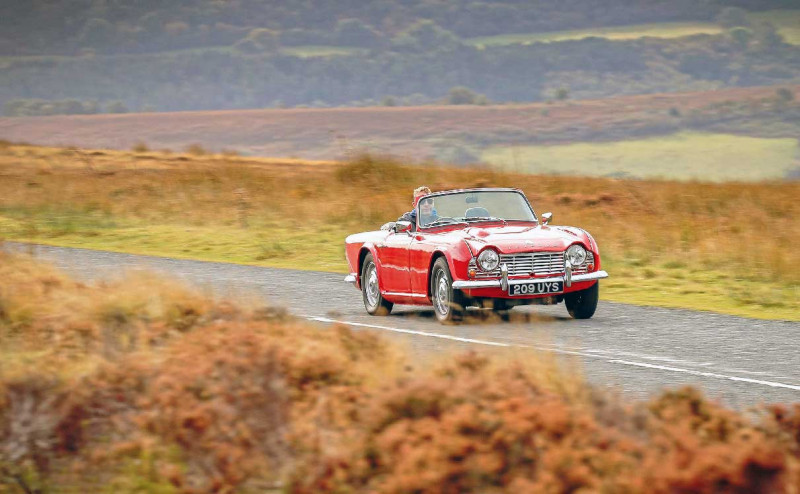
Cattle grids once again show off the car’s supple springing, making more noise than commotion as I gleefully tackle each one slightly faster than the last. But a firm push on the brakes, which are heavy but responsive as non-servo brakes should be, makes things legal again as I roll into Goathland itself.
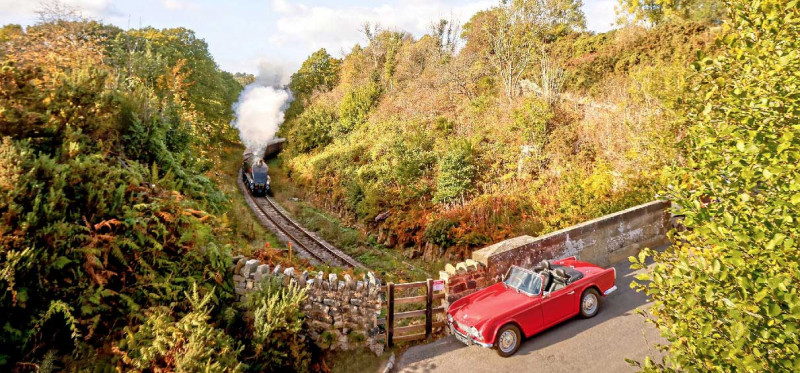
Immediately there’s the odd feeling of being part of a film set. It’s now 12 years since Heartbeat was cancelled, but by then it had been a feature of ITV’s prime time schedule for nearly two decades and a gruelling 372 episodes. So not only are various features of Goathland – known as Aidensfield in its fictional life – still showing traces of the Sixties, but people are staring at me as though I’ve just driven into view as part of a car-related sub-plot.
At least they’re smiling. Indeed, the reaction to the TR is just as you’d hope: smiles all round, with nostalgia of the ‘my dad had one of those’ type, mingled equally with those who want to know how much it’s worth and what it’s like to drive, because they’ve always fancied one and it might not be too late. So I sing the car’s praises and tell them, sincerely, that it’s never too late.
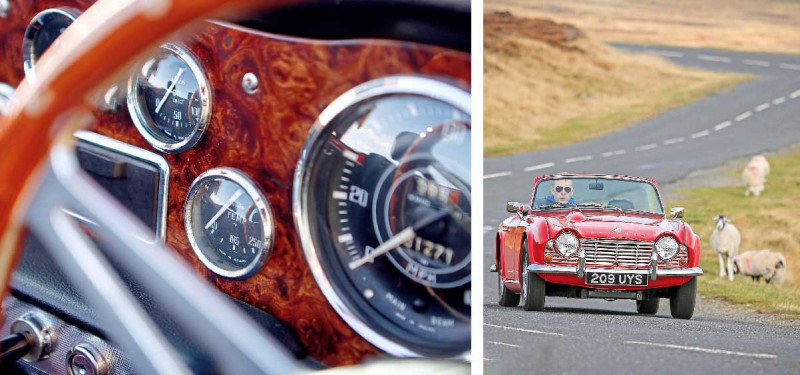
Indeed, there are probably more TR4s on the road than there were ten years ago, or 20, thanks to the quantities of un-rusty American market cars like this one that have been repatriated and restored with right-hand drive. Terms such as ‘perennially popular’ spring to mind when considering a TR, but particularly the TR4, 4A and 5, as they offer the combination of more comfortable, usable features with pretty Sixties Michelotti looks.
As I follow my nose down a side road out of Goathland, those adjacent TR models come to mind. When a standard TR4 can ride and hold the road as nicely as this one, you wonder why Triumph spent money developing the independently-suspended TR4A, but it must have been an enticing feature at a time when smaller Triumphs had swing-axle rear ends and you had to jump up to a Jaguar E-type for a properly-located IRS system. What about going back to the TR3A and 3B? Those ‘sidescreen’ TRs were almost like pre-war sports cars in their raw, open-air appeal, but here in an autumnal Yorkshire with chilly cross-winds up on top of the moors, wind-up windows seem a great idea. An all-synchromesh gearbox is nice, too.
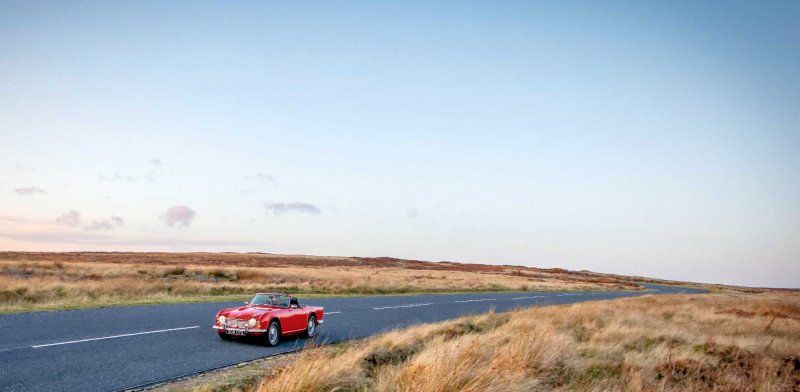
With this vote of confidence from the driver, the TR4 whirls down the surprisingly steep and sinuous hairpins to a place called Beck Hole, where a man is keeping his Fifties motorcycle company outside a pub. He toasts us with his pint as we nip up the other side of this little depression to a bridge over the railway line. I’ve had a tip-off about something special heading our way, and as I park close up against the wall, I can hear it coming.
It's not the slow chuff-chuff-chuff of a small steam loco labouring up an incline; this one sounds busy and eager. It’s thrumming along and clearly has power to spare. First, the shriek of the whistle sends all the birds in nearby trees to the air, then the Sir Nigel Gresley curves into view at the head of a long train of carriages, streaking beneath me with a blast of sound, filling the air with coal-smelling steam and whirling soot. It’s an A4 Pacific class, number 60007, and the post-war speed record holder, hitting 112mph on 23 May 1959. That’s 2mph faster than a TR4, though with rather more room for passengers. It’s named after the gentleman responsible for the design, immortalised by Mallard when it hit 126mph to become the fastest steam locomotive in the world in 1938.
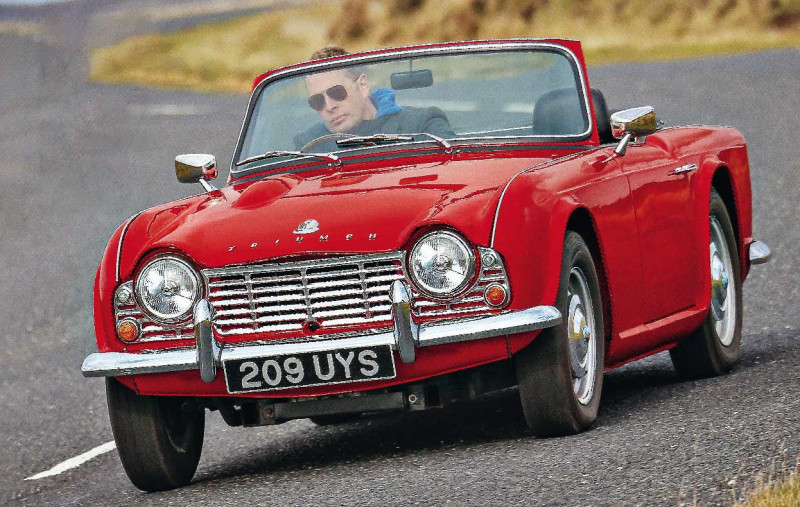
I’m not the only person on the bridge admiring the scene, and of course there’s a fair overlap between those who like old locos and those who like old cars. One chap asks if I’m heading for Blakey Ridge. Where? Only the best driving road in the whole of the North York Moors, apparently. I dig out my map and look at my watches. I wasn’t, but I certainly am now.
Blakey Ridge is one of several routes that run north-south over the Moors. Some are quiet, single-track lanes like Wheeldale Roman Road and others are important linking roads like the A169 to Whitby and the B1257 from Stokesley down to Helmsley, sometimes busy with traffic. Blakey Ridge, I’m told, has neither of those shortcomings. It certainly seems unlikely to be busy, because it doesn’t really link anywhere much to anywhere else – there’s the small group of villages in Eskdale at the north side of the Moors and just the A170 to Thirsk or Scarborough at the southern end, but I’m not expecting much of a rush hour.
Picking my way through Egton, Glaisdale, Danby and Castleton requires concentration to avoid getting lost, and more than once I’m glad of the TR’s taxi-like turning circle as I wrongslot a junction and have to backtrack.

Then, south of Castleton, the road starts climbing like a jet airliner at the end of a runway. Straight, steep, and excitingly fast. Winding the TR4 out through each gear, side windows down, is a moment that would get a tick on many bucket lists. The roaring in-draught of those two SU carburettors is competing with the raucous exhaust and the wind, which is shooting past and over the windscreen to form eddies of chilly Yorkshire air that make you turn your collar up. But it’s worth it – just when I think it can’t get any prettier, the road crests the first of many rises and I can see perhaps three miles ahead, the low sun making the tarmac glint like a silver ribbon in the heather. If anything, my new pal at the railway bridge has under-sold this. There’s about ten miles of it, and in case you thought it worthy of improvement there’s a pub half-way along. Understandably, the car park of the Lion Inn is dotted with motorbikes and the odd classic car. I turn here, exploring a few side-lanes before coming back to the ridge road itself. The whole route seems to tiptoe along the tops of the ridgeline, offering occasional carving bends to keep you alert between the straight bits. Cornering hard, the road beneath cold but dry, I only gain more and more confidence in the TR4. There’s none of that stiff-old-car understeer you often get from larger Britmobiles with Fifties origins, nor any hint of the alarming roll and breakaway for which the swing-axle Triumphs are known. Get it right, with the power down just through the apex on a fast, smooth bend, and it comes back onto the straight in a gentle four-wheel drift. Who would spoil such a nice, natural sports car with extra grip from wide tyres, or tighter responses from stiffer springs and damping?
As the sun sinks, it becomes genuinely nippy up here at 1400ft above sea level, so having chilled myself to the bone with an enthusiastic run down and back along the ridge, I erect the hood for the trip back to my overnight halt in Whitby. It’s a good hood – three poppers on each side to fasten, then the two cant-rail clips, wind the windows up and you’re snug. Not that the heater does much, but this is the classic British roadster experience…
Whitby is reached after a trudge down the traffic-laden A171 and for those who haven’t been, it’s well worth the trip. I park the Triumph behind a locked gate at my modest seaside bed and breaakfast and walk down the steep hill to the harbour.
After dark, it’s quiet on a weekday evening but still capable of providing the best fish ’n’ chips I’ve had in years. You could spend several days in the town before you’d exhausted the attractions connected to Captain Cook (there is an entertaining but none-too-faithful replica of Endeavour moored in the harbour), the shipping and fishing industry, the Abbey and of course Bram Stoker – this being Dracula’s landing place when he bounded ashore in the form of a huge wolf, following a shipwreck. Indeed, Stoker was poking around Whitby’s public library when he first came across the name Dracula. If he’d had a TR4 to play with, would he ever have done any work?
Seems unlikely. I want to head west today, with the aim of exploring the farther end of the North York Moors National Park, and particularly that road down to Helmsley. Back along the A171 I go, turning off onto the high Moorland lanes around Commondale and Kildale. These are great routes for narrow little British two-seaters, which sit nicely on the crown of the road without running over the verges, and it’s easy to revel in the view the TR4 offers down the bonnet. You have that bomb-shaped nacelle over the carburettors with which to aim, framing your shot with the left and right headlamp bulges. By now, all the controls seem second nature so approaches to slow corners are always enlivened by a heel-and-toe down-change, which is really ball-of-foot (on the brake) and side-of-foot (leaning over to dab the accelerator), adding much satisfaction. Only the indicator stalk continues to defeat me; its resting position is not horizontal. Leave it horizontal, and you’re indicating right, but the repeater light on the dash would be outshone by a dying glow-worm so it’s easy to miss.
By Kildale, I’m suddenly down off the Moors and into Woldlike farmland, gloriously quiet and tranquil. Even the names are picturesque, with Ingleby Greenhow popping up to give me a couple of junctions to think about. Somehow, I come through the maze of hedge-lined lanes and find my next climb back up to the high country. Clay Bank, as the road here is called, rises quickly to a nice view-point car park, but so fully stocked with dog-walkers and their MPVs that I soon move on. The B1257 offers a totally different experience from the high roads further east, lined with trees and hedges for some of its climb and then gradually descending as it leads us south, becoming a fast, open road in the bottom of the wide valley.
It’s actually just the kind of route you’d have relied on to make good progress when this car was new. The TR4 was never a motorway car; perhaps no traditional roadster with a flimsy vinyl roof could claim to be. But as for all of the four-cylinder Triumph TRs, the gearing was there to get you up to 60-odd mph nice and quickly, and if you felt like thrashing it in top, you’d crack the magic ton. But a sustained 70mph or more on threelane highways would be tiring, even with overdrive to drop the engine speed a little. What you hope for is a road like this to flow along, where 60mph – none of your new 50mph limits, thank you – is a natural safe, satisfying pace. The views are huge, the lines of sight for overtaking are excellent and the surface has none of the ripples that send shivers through the car like some of the more obscure moorland routes.
This joyful yomp could be interrupted by a visit to Rievaulx Abbey, but I’ve heard of another place that deserves a visit, and it just happens to give an excuse to do the southern half of Blakey Ridge. So I let the pretty B-road carry me into Helmsley and onto the A170 to Kirkbymoorside. A short way beyond the town is a sign to Hutton-le-Hole, and north I go once more. Hutton is a pretty little village and an ideal lunch-stop, especially if you feel like stretching your legs, because it’s laid out in a higgledypiggledy manner down a small valley with Hutton Beck running through the middle. White-fenced walkways and wooden footbridges give the place a feeling of England long ago, as do the village sheep, grazing and snoozing wherever they please. After a brief rest I wake up the TR and aim up the hill towards Blakey again. This end of the Ridge is different once more, the road curving gently left and right as it climbs through small trees and bracken, with flocks of dumpy partridge scuttling out in front of us. As the road climbs out of the softer vegetation and the heather returns, skylarks flutter higher and higher on their display flights. The TR is going beautifully, snarling away with each chance to open the throttle, carving into each bend, until I pull over on one of the wide, mossy verges that line this road. Sometimes you have to stop and take it in, after all.
The car ticks itself cool, the wind stirs the long grass and the black grouse cluck and bubble on the hillsides. I can see perhaps 20 miles in every direction, and I’ve still got a few hours to enjoy the perfect classic car for this landscape. Or is it the perfect landscape for this classic car?
The point is this: without a trip like this, you could live with a TR4 or any other classic for years on end and never experience the car at its best. Get the maps out – or read through our suggestions on the following pages – and you’ll be stunned at how many magical routes we have in these little islands. If you haven’t booked a few days off and taken your classic somewhere special, you’re really missing out. And that’s no secret.
Hutton-le-Hole is another timewarp village. Back to Blakey Ridge and beyond. Still heaps to discover. Whitby makes a pretty halt with plenty to enjoy.
Roof up at moon rise and the TR is snug ‘I’ve always fancied one of these...’ Hardly Captain Cook but we do have a map Sporty but soft enough for a proper tour.
Blakey Ridge and a chance to push the TR ever harder.
Upgraded burr walnut dash adds elegance The moor often provides these woolly chican.
The Sir Nigel Gresley meets Triumph TR4. Hurrying to the North York Moors Railway.
First climb into the moors. Now we’re motoring! Pause for an ice cream to enjoy Michelotti style Goathland. Once a TV set, could still be 1967.
Most have lost their pressed wheels to wires The world looks better through a TR4 windscreen TR4 looks best with roof and windows down Torquey twin-carb straight four makes all the right noises.
Getting to know the TR before hitting the hills
Technical data 1962 Triumph TR4
- Engine 2138cc inline four-cylinder, ohv, two H6 SU carburettors
- Max Power 100bhp @ 4700rpm
- Max Torque 127lb ft @ 3350rpm
- Steering rack and pinion
- Transmission Four-speed manual, rear-wheel drive
- Suspension Front: independent by upper and lower wishbones, coil springs, telescopic dampers.
- Rear: live axle, semi-elliptic leaf springs, telescopic dampers
- Brakes Front: hydraulic discs. Rear: hydraulic drums.
- Performance Top speed: 110mph;
- 0-60mph: 10.9sec (est)
- Weight 992kg (2184lb)
- Fuel consumption 22.5mpg
- Cost new £1032
- Value now £11,500-£30,000
TOP TEN TOURING TRIP HAZARDS
We asked Ian Glass, the vastly experienced tour organiser behind Country Lane Tours, for the most frequent failings he’s encountered. Avoid these for a trouble-free trip!
Electronic ignition
These upgrades fail, and people never seem to carry the original points and condenser to revert to standard specification. In the same vein, alternators fitted to dynamo-equipped cars seem to let their owners down. Stick with what’s original!
Engine oil
It sounds obvious but old cars consume it and you need to bring a few litres of the right grade along.
Overheating
If your classic is prone to boiling in traffic or on hills, get it sorted properly before departure and have a stress-free trip.
Oil leaks
A slow weep from the engine isn’t a problem, but brake fluid leaks or ATF from power steering or transmission need fixing.
Fuel vaporisation/running faults
Intermittent unplanned stoppages can be annoying and stressful. Let an expert sort it before you travel.
Dodgy fuel gauge
Or none! Carry a can with you if need be – some of the best roads are inevitably miles from a petrol station!
Breakdown cover
If all else fails, one phone call with top level cover gets you and the car home.
External combustion!
Carry a fire extinguisher. If you’re not on an organised tour with a back-up mechanic, carry tools, too.
Brakes
Ensure the linings/pad depth will last the trip.


